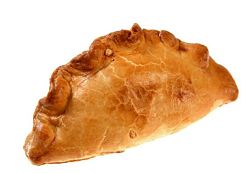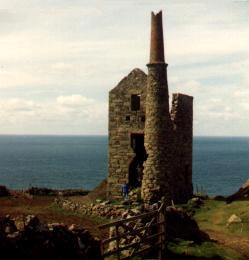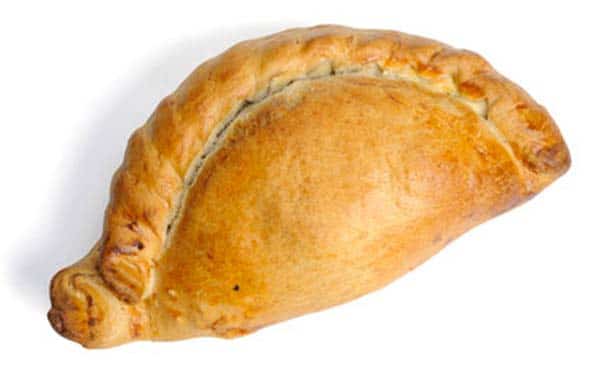 The pasty has been documented as part of the British diet since the 1200´s, when they were originally eaten by the rich upper classes and royalty. The fillings were varied and rich; venison, beef, lamb and seafood like eels, flavoured with rich gravies and fruits. It was not until the 1600´s and 1700´s that the pasty was adopted by miners and farm workers in Cornwall as a means for providing themselves with easy, tasty and sustaining meals while they worked, that the humble Cornish Pasty became popular.
The pasty has been documented as part of the British diet since the 1200´s, when they were originally eaten by the rich upper classes and royalty. The fillings were varied and rich; venison, beef, lamb and seafood like eels, flavoured with rich gravies and fruits. It was not until the 1600´s and 1700´s that the pasty was adopted by miners and farm workers in Cornwall as a means for providing themselves with easy, tasty and sustaining meals while they worked, that the humble Cornish Pasty became popular.The Cornish pasty descends from a broader family of medieval English meat pies. The earliest literary reference to pasties is likely from Chaucer’s “Canterbury Tales.” Legal records from 1200´s Norwich describe pastry makers accused of reheating three day old pasties for sale as fresh. In London, a 1350 regulation barred cooks, on pain of imprisonment, from charging more than a penny for putting a rabbit in a pasty. These pasties and the alleged venison pasty 1660´s London diarist Samuel Pepys suspected was actually beef were little more than cuts of meat wrapped in pastry dough. By then the Cornish pasty made from chipped beef, potatoes, swedes (rutabagas) and onions had already taken its place in Cornwall’s regional cuisine.
Tin had been gathered in Cornwall, first from rivers and then from ever deeper pits and shafts, since prehistoric times. In ancient Europe, Cornish tin was likely traded via intermediaries with the Phoenicians, who controlled the Mediterranean trade of the metal. Mining continued throughout the Roman and medieval eras and into the early modern period. For Cornish men and boys heading underground, the pasty amounted to a highly efficient food: self contained, self insulated and packed with calories.
 The wives of Cornish tin miners would prepare these all in one meals to provide sustenance for their spouses and sons during their gruelling days down the dark, damp mines. Working at such depths, it was not possible for them to surface at lunchtime so the first recorded packed lunch or fast food came into existence. A typical pasty is simply a filling of choice sealed within a circle of pastry, one edge crimped into a thick crust . A good pasty could survive being dropped down a mine shaft! The crust served as a means of holding the pasty with dirty hands without contaminating the meal. Arsenic commonly accompanies tin within the ore that they were mining so, to avoid arsenic poisoning in particular, the crust was an essential part of the pasty.
The wives of Cornish tin miners would prepare these all in one meals to provide sustenance for their spouses and sons during their gruelling days down the dark, damp mines. Working at such depths, it was not possible for them to surface at lunchtime so the first recorded packed lunch or fast food came into existence. A typical pasty is simply a filling of choice sealed within a circle of pastry, one edge crimped into a thick crust . A good pasty could survive being dropped down a mine shaft! The crust served as a means of holding the pasty with dirty hands without contaminating the meal. Arsenic commonly accompanies tin within the ore that they were mining so, to avoid arsenic poisoning in particular, the crust was an essential part of the pasty.The traditional recipe for the pasty filling is beef with potato, onion and swede, which when cooked together forms a rich gravy, all sealed in its own packet! As meat was much more expensive in the 1600´s and 1700´s, its presence was scarce and so pasties traditionally contained much more vegetable than today. The presence of carrot in a pasty, although common now, was originally the mark of an inferior pasty.
Ideas for the filling are endless and can be made to suit individual tastes. There is much debate as to whether the ingredients should be mixed together before they are put in the pasty or lined up on the pastry in a certain order, with pastry partitions. However, there is agreement that the meat should be chopped, not necessarily minced, the vegetables sliced and none should be cooked before they are sealed within the pastry. It is this that makes the Cornish pasty different from other similar foods.
 It was such a commonly used method of eating amongst the miners that some mines had stoves down the mine shafts specifically to cook the raw pasties. And this is how the well known British rhyme “Oggie, Oggie, Oggie” came about. “Oggie” derives from “Hoggan”, Cornish for pasty and it was shouted down the mine shaft by the maidens who were cooking the pasties, when they were ready for eating. In reply, the miners would shout “Oi, Oi, Oi!” However, if they were cooked in the mornings, the pastry could keep the fillings warm for 8-10 hours and, when held close to the body, keep the miners warm too. It is interesting to note that at the Royal Tournament, the Royal Navy field gun crews from Portsmouth, Chatham and Devonport would compete against each other. The Devonport team were urged on by the audience by shouting “Oggie, Oggie, Oggie”
It was such a commonly used method of eating amongst the miners that some mines had stoves down the mine shafts specifically to cook the raw pasties. And this is how the well known British rhyme “Oggie, Oggie, Oggie” came about. “Oggie” derives from “Hoggan”, Cornish for pasty and it was shouted down the mine shaft by the maidens who were cooking the pasties, when they were ready for eating. In reply, the miners would shout “Oi, Oi, Oi!” However, if they were cooked in the mornings, the pastry could keep the fillings warm for 8-10 hours and, when held close to the body, keep the miners warm too. It is interesting to note that at the Royal Tournament, the Royal Navy field gun crews from Portsmouth, Chatham and Devonport would compete against each other. The Devonport team were urged on by the audience by shouting “Oggie, Oggie, Oggie”It was also common for the pasties to provide not only a hearty, savoury main course lunch, but also a sweet or fruity desert course. The savoury filling would be cooked at one end of the crescent and the sweet course at the other end. Hopefully these ends would be marked on the outside.
 With its characteristic semicircular shape, the Cornish pasty today receives special designation, along with Champagne and Parma ham, as a protected regional food by the European Union. Today you can find pasties with all sorts of fillings, but since 2011 the European Union’s rules for what constitutes a true Cornish pasty have been much more restrictive. To be a Cornish pasty, you must have potato, swede, onion and beef, with the filling containing at least 25 percent vegetables and at least 12.5 percent meat. Most importantly, the pasty must be made in Cornwall. Cornish tradition, though, allows for a little more variety.
With its characteristic semicircular shape, the Cornish pasty today receives special designation, along with Champagne and Parma ham, as a protected regional food by the European Union. Today you can find pasties with all sorts of fillings, but since 2011 the European Union’s rules for what constitutes a true Cornish pasty have been much more restrictive. To be a Cornish pasty, you must have potato, swede, onion and beef, with the filling containing at least 25 percent vegetables and at least 12.5 percent meat. Most importantly, the pasty must be made in Cornwall. Cornish tradition, though, allows for a little more variety.Although there are now many national businesses that trade in Cornish pasties, any local would tell you that none compare to traditional home baked pasties.
Superstition
There are superstitions and beliefs surrounding the humble pasty that have been passed on through the ages and accepted as ritual. Firstly, it was said that the Devil would never cross the River Tamar into Cornwall for fear of becoming a filling of a Cornish pasty after hearing of the Cornish women’s inclination to turn anything into a tasty filling!
The next relates to the crusts of the pasty. A Cornish wife would mark her husband’s pasty with his initials so that if he saved some of his pasty for an afternoon break, he could distinguish his from his colleagues. It was also so that the miner could leave part of his pasty and the crust to the “Knockers”. The Knockers are mischievous “little people”, or sprites, who live in the mines and were believed to cause havoc and misfortune unless they were bribed with small amounts of food. The initials carved into the pasties, it is assumed, made sure that those miners who left their crusts for the “Knockers” could be determined from those who did not.
In the 1200´s when pasties were part of the diet of the rich and aristocratic, seafood was a common filling. However, in Cornwall, a county much in tune and dependant on the sea, the use of seafood in a pasty was unthinkable and inappropriate. Amongst the most superstitious of Cornish fisherman, even having a pasty on board their ship was believed to bring bad tidings! This belief is thought to have been started by the Cornish tin mining families who did not want their ingenious pasty invention to be adopted by the fishing trade.
They may not have wanted another trade to use the idea but when migrants from the Cornish tin mining community moved into other counties of England and across to America, in search of work, they took with them their pastry crescent filled with a hearty meal.
America
The Cornish pasty arrived in Michigan’s Upper Peninsula (U.P.) in the 1840 ´s, just a few years after Michigan’s present-day boundaries were carved out of the former Northwest Territory. Adventurers crossed the Straits of Mackinac to the isolated U.P. to prospect for minerals, discovering significant iron and copper deposits beneath the northern forests. Experienced miners from Cornwall immigrated to help develop the mines, bringing pasty-making with them. Although Cornish migration was soon supplanted by much larger waves of Finns and Italians, the pasty took hold as a traditional miners’ food.
 In their seminal study of the Cornish pasty in Northern Michigan, folklorists William and Yvonne Lockwood describe how the pasty was adopted by Finnish and Italian miners, who looked to their Cornish supervisors for cues on how to behave in American culture. By the mid 1900´s, the pasty was so firmly entrenched among all the Upper Peninsula’s ethnic groups that it was common to find locals who assumed that the pasty was of Finnish or even Italian origin. Each culture had their own take on the traditional recipe, with the Finns often controversially substituting carrots for the traditional rutabaga. Other locals emphasized the pasty’s true origins, referring to the dish as the “Cousin Jack mouth organ”—that is, a Cornishman’s harmonica.
In their seminal study of the Cornish pasty in Northern Michigan, folklorists William and Yvonne Lockwood describe how the pasty was adopted by Finnish and Italian miners, who looked to their Cornish supervisors for cues on how to behave in American culture. By the mid 1900´s, the pasty was so firmly entrenched among all the Upper Peninsula’s ethnic groups that it was common to find locals who assumed that the pasty was of Finnish or even Italian origin. Each culture had their own take on the traditional recipe, with the Finns often controversially substituting carrots for the traditional rutabaga. Other locals emphasized the pasty’s true origins, referring to the dish as the “Cousin Jack mouth organ”—that is, a Cornishman’s harmonica.After the 1957 Mackinac Bridge opened the Upper Peninsula for tourism from southern Michigan, the pasty shifted from being a food mainly cooked at home by U.P. locals who were known as “Yoopers”, to one sold at restaurants to visitors from southern Michigan and beyond, playfully derided as “Fudgies” for their preferred dessert. In a moment of Yooper-Fudgie unity, Gov. George Romney declared May 24, 1968 to be the first statewide Michigan Pasty Day.
